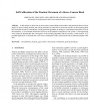Free Online Productivity Tools
i2Speak
i2Symbol
i2OCR
iTex2Img
iWeb2Print
iWeb2Shot
i2Type
iPdf2Split
iPdf2Merge
i2Bopomofo
i2Arabic
i2Style
i2Image
i2PDF
iLatex2Rtf
Sci2ools
AROBOTS
1998
1998
Self Calibration of the Fixation Movement of a Stereo Camera Head
In this article we show how an active stereo camera head can be made to autonomously learn to fixate objects in space. During fixation, the system performs an initial and a correction saccade. In the learning phase the correction saccade is controlled by a crude prewired algorithm, in analogy to a mechanism surmised to exist in the brainstem. A vector-based neural network serves as the adaptive component in our system. A self-organizing fovea improves dramatically the convergence of the learning algorithm and the accuracy of the fixation. As a possible application we describe the visuo-motor coordination of the camera head with an anthropomorphic robot arm.
| Added | 21 Dec 2010 |
| Updated | 21 Dec 2010 |
| Type | Journal |
| Year | 1998 |
| Where | AROBOTS |
| Authors | Mike Pagel, Eric Maël, Christoph von der Malsburg |
Comments (0)

